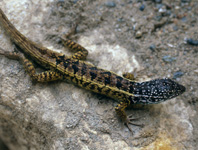Abstract
Two new species of the free-living marine nematode genus Deontolaimus (Leptolaimidae) are described from mangrove forests of the Can Gio Biosphere Reserve and Tien Yen, Quang Ninh, Vietnam. D. mangrovi sp. nov. is distinguished from D. papillatus de Man, 1880 and D. cangioensis sp. nov. by tail shape: conical and then elongated, without pointed tip. Deontolaimus cangioensis sp. nov. resembles D. papillatus in body shape, especially in the pointed tail terminus. D. cangioensis differs from D. papillatus in having a complicated gubernaculum with dorsally curved apophyses.
References
Alekseev, V.M. (1981) Nematodes of the family Leptolaimidae (Nematoda, Araeolaimidae) from the brackish water of the South Sakhalin. Svobodnozhivushchie I fitopatogennye nematody fauny Dalnego Vostoka, 3 (7), 64–67.
De Coninck, L.A.P. (1944) Wetenschappelijke resultaten der studiereis van Prof. Dr. P. van Oye op Ijsland XVI. Les Nematodes libres des eaux et des Terres Saumatres. Biologisch Jaarboek Dodonaea,11, 165–220.
De Ley, P. & Blaxter, M.L. (2002) Systematic position and phylogeny, In: Lee, D.L. (Ed.), The Biology of Nematodes, London, Taylor and Francis, pp. 1–30.
https://doi.org/10.1201/b12614-2Heip, C., Vincx, M. & Vranken, G.(1985) The ecology of marine nematodes.Oceanography and Marine Biology: An Annual Review, 23, 399–489.
Holovachov, O. & Boström, S. (2004) Morphology and systematics of the superfamilies Leptolaimoidea Örley, 1880 and Camacolaimoidea Micoletzky, 1924 (Nematoda: Plectida)..Journal of Nematode Morphology and Systematics, 7, 1–49.
Holovachov, O. (2006) Morphology and systematics of Order Plectida Malakhov, 1982 (Nematoda). Ph.D. Thesis, Wageningen University and Research Centre, the Netherlands, 244 pp.
Holovachov, O. & Bostrom, S. (2015) Swedish Plectida (Nematoda). Part 10. The genus Deontolaimus de Man, 1880. Zootaxa, 4034 (1), 1–44.
https://doi.org/10.11646/zootaxa.4034.1.1Loof, P.A.A. (1961) The nematode collection of Dr. J.G. de Man. Beaufortia,8 (93), 169–254.
Lorenzen, S. (1969) Freilebende Meeresnematoden aus dem Schlickwatt und den Salzwiezen der Nordseeküste. Veröffentlichungen des Instituts für Meeresforschung in Bremerhaven,11, 195–238.
Malakhov, V.V., Ryzhykov, K.M. & Sonin, M.D. (1982) [System of higher taxa ofnematodes]. Zoologicheskii Zhurnal 64, 1125–1134. [in Russian]
Micoletzky, H. (1924) Letzter Bericht über freilebende Nematoden aus Suez. Sber. Akad. Wiss. Wien Mathem.-naturw. Klasse. Abteilung I, Band 133, Heft 4/6, 137–179.
de Man, J.G. (1880) Die einheimischen, frei in der reinen Erde und im süßen wasser lebenden Nematoden. Vorläufige Bericht und descriptiv-systematischer Theil. Tijdschrift Nederlandsche dierkundige Vereeniging, 5, 1–104.
de Man, J.G. (1921) Nouvelles recherches sur les Nématodes libres terricoles de la Hollande. Capita Zoologica, 1 (1), 1–62.
Örley, L. (1880) Az anguillulidák magánrajza. Természetrajzi Füzetek, 4, 1–165
Riemann, F. (1978) Nematoda. In: Higgins, R.P. & Thiel, H. (Eds.) Introduction to the study of meiofauna. Smithsonian Institution Press, Washington DC, pp. 293–301.
Seinhorst, J.W. (1959) A rapid method for the transfer of nematodes from fixative to anhydrous glycerin. Nematologica, 4, 67–69.
https://doi.org/10.1163/187529259X00381

